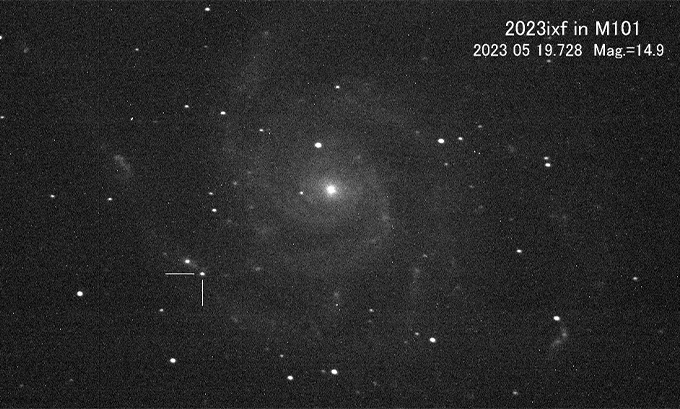This post was originally published on this site
In May, a star in the Pinwheel galaxy exploded in just the right place at nearly the right time for astronomers to unravel details of its death. It was the closest supernova to go off in the last five years.
Astronomers have long been fascinated with these stellar explosions, which signal the end of life for the universe’s biggest stars. Not only are they dramatic — a supernova can shine 5 billion times as bright as our sun — but the explosions seed the universe with gold, silver, zinc and other elements forged only in a dying star’s last moments.
And this supernova — designated SN 2023ixf — was perfectly placed for astronomers to capture it relatively soon after it went off.
Because researchers can’t predict when a star will die, they typically wouldn’t have lots of images of a supernova from shortly after it happened, says Edo Berger, an astronomer at Harvard University. But thanks to the supernova’s position in a nearby galaxy that’s popular with stargazers, scientists were able to use images from amateur astronomers to pin down when the star exploded to within just a few hours, says astronomer Daichi Hiramatsu, also at Harvard.
Having data on the explosion not long after it happened is crucial to answering many open questions about how stars’ dying moments play out. Here are three things to know about this stunning supernova.
SN 2023ixf used to be a dust-shrouded red supergiant
SN 2023ixf was first discovered by Japanese amateur astronomer Koichi Itagaki a few days after the star exploded. Almost immediately after learning about the supernova, researchers started scouring archival data for the star it used to be, says astronomer Charlie Kilpatrick of Northwestern University in Evanston, Ill. “We looked at the imaging within hours of the report,” he says.
Right away, he and his colleagues found something in Hubble Space Telescope images of the Pinwheel galaxy taken between 5 and 24 years earlier that looked like it could be the star, the supernova progenitor, that exploded as SN 2023ixf. It was a lucky find, as astronomers had no idea that the star would explode when the Hubble images were taken. Since then, other research teams have used other telescope images to independently confirm the identity of SN 2023ixf’s progenitor — a red supergiant cloaked in a dusty veil.
Stars like this one are the most common progenitors for explosions like SN 2023ixf, Kilpatrick says. And “in a lot of ways,” he notes, SN 2023ixf “is kind of a normal supernova.”
That’s a good thing, Berger says. It’s easy to get excited about supernovas that are particularly unusual. “But here we have a supernova that’s actually representative of the way that most stars die,” he says, which helps with astronomers’ overall understanding of stellar evolution.

SN 2023ixf’s final years involved extreme weight loss
Studying stellar deaths requires a bit of forensic analysis, Berger says. The star dies, but you don’t see it happen. “Then you kind of have to backtrack what the star was doing all the way up to that point,” he says. “And tracking how the star was losing mass is a critical part of that.”
Berger and Hiramatsu recently published results suggesting that the star that exploded as SN 2023ixf lost an incredible amount of mass in its final years — an entire sun’s worth, which was far more than expected.
To reconstruct these dramatic stellar death throes, the researchers scrutinized the light cast as SN 2023ixf exploded. As the star collapsed, it emitted a shock wave that set off a bright flash of light as the wave collided with material surrounding the star — including mass lost before the explosion. Using the explosion’s light to map out this material allowed the team to reconstruct SN 2023ixf’s mass loss rates leading up to the explosion.
Red supergiants are known to lose mass leading up to a supernova, but far less than in the final years before this latest explosion, Hiramatsu says. Something changed for SN 2023ixf’s progenitor star — something that might happen to other stars, too, and that researchers still don’t understand.
“Stellar evolution theory is just not up to the task” to tell us, Berger says. To figure out what happens in the last moments of a star’s long life, “we have to do it from data.” And this supernova is a rare chance to gather some of that data.
“It’s an incredible opportunity,” Kilpatrick says.
SN 2023ixf is the nearest supernova of the multi-messenger era
Historically, light cast by a supernova would be the only cosmic “messenger” astronomers could use to learn about the event. But “one type of messenger is not enough for us to recover all the mysterious things about this kind of collapsing star,” says astrophysicist Zidu Lin of the University of Tennessee, Knoxville, who studies ghostly subatomic particles called neutrinos, which interact only very weakly with matter.
Fortunately, it’s now possible to detect neutrinos or gravitational waves streaming away from certain celestial objects — possibly including stellar explosions like SN 2023ixf. At just more than 21 million light-years away, the supernova is the closest of its kind to light up the sky within the era of modern “multi-messenger” astronomy. Today’s technology isn’t quite sensitive enough to catch gravitational waves or low energy neutrinos from supernovas outside the Milky Way, including SN 2023ixf, Lin says. However, it is possible to detect a few high energy neutrinos from supernovas in nearby galaxies, like the Pinwheel.
It was a bit surprising, then, none were detected from SN 2023ixf, researchers reported in September. “The nondetection of the high energy neutrinos, combined with some optical signals, might be able to form a multi-messenger analysis,” Lin says. In particular, it could help astronomers constrain ideas about exactly how high energy neutrinos are generated within dying stars.
